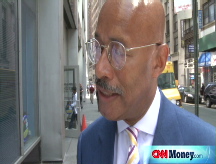Pick-a-payment loans turn poisonous
Defaults on option ARM mortgages are expected to double in the next two years, driving foreclosure rates even higher.
| 30 yr fixed | 3.80% |
| 15 yr fixed | 3.20% |
| 5/1 ARM | 3.84% |
| 30 yr refi | 3.82% |
| 15 yr refi | 3.20% |
NEW YORK (CNNMoney.com) -- They're known as "pick-a-payment" mortgages or option ARMs, but their detractors call them pure poison. Now their default rates, which are already high, are about to explode, according to a Fitch Ratings report issued Tuesday.
Option ARMs are loans that allow borrowers to make very low minimum payments that don't even cover the interest for the loans. The difference is then added to the mortgage balance, which grows every month.
There are about one million option ARMs outstanding, according to Fitch, and somewhere between 10% and 24% of these are seriously delinquent - 90 days or more past due.
But payments are slated to jump for large numbers of option ARM borrowers in the next two years, which Fitch predicts will double that delinquency rate.
"These things have their own private hell," said Keith Gumbinger of HSH Associates, a publisher of mortgage information. "The reset trigger is absolutely coming."
Borrowers who take out option ARM loans have four payment options. They can make the minimum payment, which doesn't cover all of the interest; an interest-only payment; a payment that pays off the loans in 30 years; or one that would pay it off in 15 years.
The problem is most borrowers pay just the minimum. According to First American LoanPerformance, which tracks the mortgage market, more than 65% of option ARM borrowers make only minimum payments every month. They can continue to do that for up to five years, or until their loan balance reaches 110% to 125% of the original principal.
After that, borrowers have to start paying at a higher rate that will pay down their principal, which can mean skyrocketing monthly payments. Fitch estimates that the average borrower's bill will increase 63% from $1,672 to $2,735.
As a result, Fitch predicts defaults on these loans will double, adding to the nation's already soaring foreclosure rates.
During the boom, option ARMs were often the only way that borrowers could buy wildly appreciating real estate. Indeed, lenders actually approved these loans based only on whether borrowers could afford to make the minimum payments.
Homeowners were counting on the fact that the value of their property would continue to soar, so that they could either refinance or sell when the minimum payment option expired.
Fitch reported that of the $200 billion in option ARMs outstanding, $29 billion worth will convert to what are called "fully amortizing loans," with payments that will reduce the loan balances, by the end of 2009. Another $67 billion will convert to fully amortizing loans through the end of 2010. That represents nearly half a million borrowers.
And, although option ARMs make up only a little more than 2% of all mortgages outstanding, they were concentrated in some of the most over-heated housing markets, which are now suffering heavy price losses.
With property values dropping 20% or 30%, many of these homeowners will be severely "upside-down" on their mortgages, owing much more than their homes are worth. Borrowers could find themselves owing $500,000 on houses worth only $300,000.
Refinancing such option ARM loans into fixed rate mortgages would be very difficult. Lenders won't issue a mortgage for more than the appraised value of a property, so someone with a $500,000 loan on a $300,000 house would have to pony up more than $200,000. If they can't they could lose their homes.
Even homeowners who could afford to continue to make the increased payments may decide that continuing to do so makes little financial sense, and just walk away from their mortgages.
"Your payment is going to go up exponentially," said Gumbinger, "and your ability to pay will not. You just might chuck your keys in an envelope and mail it to your bank." ![]()




